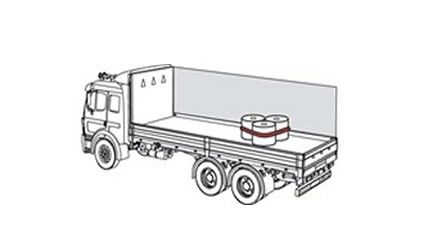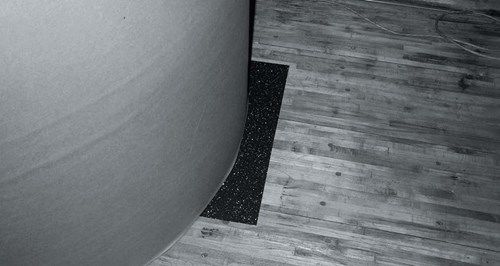CDL Practice Tests: Flatbed Cargo Securement
Choose A Section:
Go!Which of the following is not true of Working Load Limit (WLL)?
- The Working Load Limit is the maximum load that may be applied to a component of a cargo securement system.
- The WLL is usually assigned by the component manufacturer.
- All of these are true.
- The minimum WLL requirement for the securement system is 25%.
The Working Load Limit is the maximum load that may be applied to a component of a cargo securement system during normal service.
The WLL is usually assigned by the component manufacturer.
Note: The minimum WLL requirement for the securement system is 50%. More tiedown capacity should be used if you need to secure an article against any movement.
One option of positioning bundles of building materials is:
- Turn them so only their corners are touching.
- Place them in direct contact with each other.
- Lean them to the outside.
- Lean them against each other.
Choose one of two options for positioning bundles:
-
Option #1:
Place bundles in direct contact with each other.
-
Option #2:
Provide a means (such as dunnage or blocking) to prevent the bundles from shifting towards each other.
When securing a paper roll with a width that is more than twice its diameter, which of the following is not an acceptable method of securement to prevent tipping?
- Use tiedowns.
- Band the roll to other rolls.
- Use rear doors to brace it.
- Brace it.
Situation #1:
- Paper roll is not prevented from tipping by the vehicle structure or other cargo.
- Paper roll width is more than 2 times its diameter.
Solution #1:

- Either band the roll to other rolls.
- Or brace it.
- Or use tiedowns.
A hook-lift container is:
- A reusable, transportable enclosure that is especially designed with integral locking devices that secure it to a container chassis trailer to facilitate the efficient and bulk shipping and transfer of goods by, or between various modes of transport, such as highway, rail, sea, and air.
- A specialized container, primarily used to contain and transport materials in the waste, recycling, construction/demolition, and scrap industries, which are used in conjunction with specialized vehicles, in which the container isloaded and unloaded onto a tilt frame body by an articulating hook-arm.
- The load carrying area of a truck, trailer, or intermodal container.
- A vehicle especially built and fitted with locking devices for the transport of intermodal containers.
Hook-lift Container:
A specialized container, primarily used to contain and transport materials in the waste, recycling, construction/demolition, and scrap industries, which are used in conjunction with specialized vehicles, in which the container isloaded and unloaded onto a tilt frame body by an articulating hook-arm.
What is the minimum WLL of a tiedown used to secure logs?
- 1,800 lb
- 50% of cargo weight
- 4,000 lb
- It depends on if you are hauling shortwood or longwood
- Use tiedowns in combination with bunks, stakes, or standards and bolsters to secure the load.
- All tiedowns must have a working load limit not less than 1,800 kg (4,000 lb.).
- Tension tiedowns as tightly as possible but not beyond their working load limit.
When securing building materials, how many knots are acceptable in the tiedown(s)?
- Depends on the weight of the cargo.
- 1
- 2
- 0
Requirements for Securement System:
- In proper working order with no damaged or weakened components that affect their performance or reduce their working load limit.
- No knots.
- Attached and secured in a manner that prevents them from coming loose during transit.
- Able to be tightened by a driver of an in-transit vehicle.
- Located inboard of rub rails whenever practicable.
- Edge protection must be used when a tiedown would be subject to abrasion or cutting.
When securing paper rolls with friction mats as a primary method:
- All of these answers.
- The friction mat should stick out from underneath the roll in the direction it is providing securement.
- The friction mat should stick out from underneath the roll in the opposite direction for which it is providing securement.
- Make sure friction mats are completely covered by the roll.
Requirements for friction mats

If a friction mat is used to provide the principal securement for a paper roll, insert the friction mat so that it sticks out from beneath the footprint of the roll in the direction in which it is providing securement.
Banding is:
- A combination of securing devices which form an assembly that attaches cargo to, or restrains cargo on, a vehicle or trailer, and is attached to anchor point(s).
- Material used to fill a void between articles of cargo and the structure of the vehicle that has sufficient strength to prevent movement of the articles of cargo.
- A strip of material that may be used to unitize articles and is tensioned and clamped or crimped back upon itself. (same as "Strapping")
- A device placed on the exposed edge of an article to distribute tiedown forces over a larger area of cargo than the tiedown itself, to protect the tie-down and/or cargo from damage, and to allow the tiedown to slide freely when being tensioned.
Banding:
A strip of material that may be used to unitize articles and is tensioned and clamped or crimped back upon itself. (same as "Strapping")
When securing concrete bell pipe in multiple complete tiers, all of the following are true except:
- All of these apply.
- Stack the tiers in pyramid fashion.
- Bells of the upper tiers must all be on the opposite side of the vehicle from the bells of the tier below.
- Bells of the bottom tier must all be on the same side of the vehicle
More than one tier with complete tiers

Bells of the bottom tier must all be on the same side of the vehicle
Bells of the upper tiers must be are on the opposite side of the vehicle from the bells of the tier below.
Which of the following are not covered by the specific log securement requirements?
- Logs unitized by banding or other comparable means.
- Loads of no more than four processed logs.
- None of these are covered by the specific log requirements
- Firewood, stumps, debris, other short logs, and longer logs.
The following types of logs are not covered by the specific logs requirements:
- Logs unitized by banding or other comparable means. [Secure according to general cargo securement requirements.]
- Loads of no more than four processed logs. [Secure according to general cargo securement requirements.]
- Firewood, stumps, debris, other short logs, and longer logs. [Transport in a vehicle or container enclosed on both sides, the front, and the rear and strong enough to contain them.]
About The Flatbed Cargo Securement CDL Manual
Studying the flatbed cargo securement CDL manual is not a requirement for getting your CDL permit or license. It is required knowledge for flatbed drivers.
Some questions you should be able to answer for flatbed cargo securement:
- What is the minimum Working Load Limit of a tiedown used to secure logs?
- What is the minimum weight of a shipment of paper rolls that would require specific securement requirements?
- When securing concrete pipe over 45 inches loaded crosswise, which direction must the tiedowns on the front half of the load run?
- What is a cab shield?
- When securing concrete pipe over 45 inches loaded crosswise, which direction must the tiedowns on the rear half of the load run?
- What is a dunnage bag?
- Who is responsible for inspecting securing devices and cargo within the first 50 miles?
- How many tiedowns are required on a stack of shortwood loaded crosswise?
- What is the minimum working load limit of each tiedown used to secure crushed or flattened vehicles?
- Define 'bolster'
- What is a hook-lift container?
- When a tiedown is attached directly to the cargo, what is the ideal angle where it attached to the vehicle?
What is a securing device?
Any device specifically manufactured to attach or secure cargo to a vehicle or trailer:
- Synthetic Webbing
- Chain
- Wire rope
- Manila rope
- Synthetic rope
- Steel strapping
- Clamps and latches
- Blocking
- Front-end structure
- Grab hooks
- Binders
- Shackles
- Winches
- Stake pockets
- D-rings
- Webbing ratchet
- Bracing
- Friction mat
What is a tiedown?
A combination of securing devices that forms an assembly that:
- Attaches cargo to, or restrains cargo on a vehicle.
- Is attached to anchor point(s).

Some tiedowns are attached to the cargo and provide direct resistance to restrain the cargo from movement.

Some tie-downs pass over or through the cargo. They create a downward force that increases the effect of friction between the cargo and the deck. This friction restrains the cargo.
 Related Cargo Securement Terms That Every Driver Should Know:
Related Cargo Securement Terms That Every Driver Should Know:
-
Tiedown:
A combination of securing devices which form an assembly that attaches cargo to, or restrains cargo on, a vehicle or trailer, and is attached to anchor point(s).
-
Contained:
Cargo is contained if it fills a sided vehicle, and every article is in contact with or sufficiently close to a wall or other articles so that it cannot shift or tip if those other articles are also unable to shift or tip.
-
Blocking:
A structure, device, or another substantial article placed against or around an article to prevent horizontal movement of the article.
How should tiedowns be attached?
Tiedowns can be used in two ways:
-
Attached to the cargo:
- Tiedowns attached to the vehicle and attached to the cargo.
- Tiedowns attached to the vehicle, pass through or aroundan article of cargo, and then are attached to the vehicle again.
-
Pass over the cargo:
- Tiedowns attached to the vehicle, passed over the cargo, and then attached to the vehicle again.
Tiedown placement:

Place the tiedown as close as possible to the spacer.
Position the tiedowns as symetrically as possible over the length of the article.

Position the tiedowns to preserve the integrity of the article.







 TT On Facebook
TT On Facebook